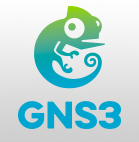GNS3 1.0 beta and Cisco IOU

Hello!
Most recently, the public beta of the popular GNS3 1.0 network equipment simulator has been released. It is interesting first of all because it began to support switching (it used to support only routing before) with the help of Cisco IOU . Since I use it, starting with the alpha version, I decided to write a small guide on how to make friends with GNS3 and IOU.
')
Disclaimer Cisco IOUs can only be used by Cisco employees.
Below is a guide for both Windows and Linux.
Windows
On the official GNS3 website, download All in One Installer for Windows.
Together with GNS3, you will be prompted to install SuperPutty, Wireshark, WinPcap and some other programs.
After installation, you can already use the basic functionality of this simulator (routing) using Dynamips. But at this stage IOU will not work yet.
We need VirtualBox , the OVA virtualka created by the GNS3 team, and IOU images.
I can not post links to IOU images, which does not negate the fact that you can find everything you need on the Internet. Today the most popular are these 2 images:
l2-adventerprise-ms.nov11-2013-team_track
l3-adventerprisek9-15.4.1T
Download the virtual here .
Open VirtualBox , add this virtual machine using File -> Import Appliance . Go to the VM settings -> Serial Ports -> remove the tick Enable serial port , save the settings and start the virtual machine.
Go to the browser at http: // <your virtual address>: 8000 / upload , if you use the default settings for VirtualBox, then the address will be as follows:
192.168.56.101:8000/upload
Add IOU images here and copy the path to each image, for example:
/home/gns3/GNS3/images/i86bi-linux-l3-adventerprisek9-15.4.1T.bin
Open GNS3 -> Edit -> Preferences -> GNS3 Server -> Remote Servers , add the address and port of the web server on the virtual machine, in our case it is 192.168.56.101, 8000 TCP , click Add -> Apply .
Open Edit -> Preferences -> IOU Devices , add the copied path to the IOU path field and click Save . We make for each image.
Select the IOS on UNIX partition, and in the Path to IOURC field, specify the path to the IOURC license text file (I unfortunately cannot post it).
Everything, now you can add IOU devices from the panel Routers -> IOU device or Switches -> IOU device .
Linux (using the example of Ubuntu x64 14.04)
In order for GNS3 1.0 to work under Linux, we need to make sure that we have python3, pip, pyQt installed:
sudo apt-get install python3 python3-pip python3-pyqt4 We also need to build Dynamips from sources:
sudo apt-get install libelf-dev uuid-dev libpcap0.8-dev cmake git git clone git://github.com/GNS3/dynamips.git cd dynamips mkdir build cd build cmake .. sudo make install Now build GNS3 GUI and Server :
cd ~ git clone https://github.com/GNS3/gns3-gui.git cd gns3-gui sudo python3 setup.py install cd ~ git clone https://github.com/GNS3/gns3-server.git sudo apt-get install python3-zmq python3-tornado python3-netifaces cd gns3-server sudo python3 setup.py install To get rid of errors when entering settings, you can install VirtualBox , build and install vboxwrapper :
cd ~ git clone https://github.com/GNS3/vboxwrapper sudo apt-get install python-pip cd vboxwrapper sudo python2 setup.py install sudo cp vboxwrapper.py tcp_pipe_proxy.py vboxcontroller_4_3.py /usr/local/lib/python2.7/dist-packages/ It remains only to install iouyap to make IOU work. You can download the already compiled or compile from source. I chose the first option:
tar -zxvf iouyap.tar.gz sudo cp iouyap /usr/local/bin/iouyap Before we get into tuning, we need to do one more thing. The fact is that GNS3 will run some 32-bit binaries on a 64-bit system. To do this, you must perform additional steps:
sudo dpkg --add-architecture i386 sudo apt-get update sudo apt-get install libc6:i386 libstdc++6:i386 sudo apt-get install libssl1.0.0:i386 sudo ln -s /lib/i386-linux-gnu/libcrypto.so.1.0.0 /lib/i386-linux-gnu/libcrypto.so.4 As in the case of installation under Windows, we need to have IOU images (images) and iourc license file .
It remains only to configure GNS3 and everything is ready.
We start gns3 using the gns3 command in the terminal.
Go to Edit -> Preferences . In the section GNS3 Server we write the path: / usr / local / bin / gns3server
In the Dynamips section, write the path: / usr / local / bin / dynamips
In the section VirtualBox we write the path: / usr / local / bin / vboxwrapper
In the IOS on Unix section, we write the path to iouyap : / usr / local / bin / iouyap and the path to the iourc license file .
In the IOU Devices section, in the IOU path field, set the path for each image and click Save .
Optionally, you can change the console in the section General -> Console Applications . For GNS3, I use KDE Konsole instead of Gnome Terminal , since the latter connects to all devices in different windows, not tabs.
Now it only remains to check whether everything works.

Everything worked for
Observations and observations
- Under Windows, I used only the second alpha GNS3, with a large number of devices, the processor load reached 70-80%, and sometimes everything slowed down a lot. Therefore, since the advent of the public beta, I have been using GNS3 in the ubuntu virtual machine. Judging by the sensations, it is much more comfortable to work like this.NoteI apologize if any commands in the terminal should be used without sudo or others, I'm not a Linux specialist.
- Now you can prepare for CCNP without real equipment, which is good news. Unfortunately, some features do not work. The problem is not in GNS3, but in available images. I hope that soon IOU will introduce support for these features. For example, Private VLAN, L3 PortChannel, DHCP snooping and some other features do not work.
- The new GNS3 uses a different topology file format (now it's JSON), which is incompatible with the previous version of GNS3, which is why all available labs just won't start (although you can write a script from one to another if you want).
Source: https://habr.com/ru/post/234195/
All Articles